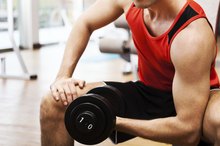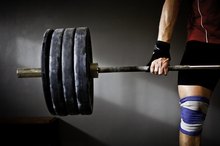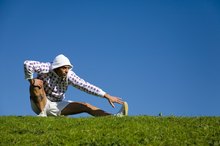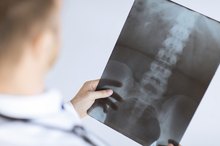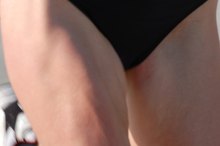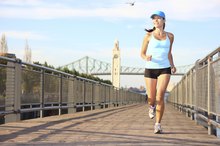How Does Exercise Increase Bone Density?
The adult human body is comprised of 206 bones. These bones provide us with a rigid support structure that, along with the actions of muscles, allows us to move and function each day. Just like muscles, bones can become stronger too, and while the exercise you perform increases your muscle strength, it can also increases your bone strength, or bone density.
Bone Formation
Bone is formed after a stress has been placed upon it. After a mechanical load, such as the extra weight applied when performing the squat exercise or when running, has been applied to the bone, bone cells migrate to the stressed area, and begin the process of laying down new bone. The bone cells manufacture and secrete proteins, mainly collagen, which is deposited in between the bone cells to increase bone strength in that area. These proteins eventually mineralize, giving bone its characteristic rigidity.
- Bone is formed after a stress has been placed upon it.
- After a mechanical load, such as the extra weight applied when performing the squat exercise or when running, has been applied to the bone, bone cells migrate to the stressed area, and begin the process of laying down new bone.
Minimal Essential Strain
How Diet & Exercise Affect the Skeletal System
Learn More
Because bone grows after experiencing a stress, there needs to be a threshold level that determines what signifies a significant amount of stress to promote growth. This threshold level is termed the minimal essential strain, and it is determined by the level of activity you do on a daily basis. If a force falls below this level, it does not stimulate growth. If a force reaches or exceeds the level, such as when performing a weight-bearing resistance or aerobic exercise, bone cells are stimulated to produce collagen, beginning the process of bone formation.
- Because bone grows after experiencing a stress, there needs to be a threshold level that determines what signifies a significant amount of stress to promote growth.
- If a force reaches or exceeds the level, such as when performing a weight-bearing resistance or aerobic exercise, bone cells are stimulated to produce collagen, beginning the process of bone formation.
Progressive Overload
Both bone and muscle respond to mechanical loads, or stresses, that pose a threat. Therefore, the principle of progressive overload, which progressively places higher than normal demands on the working musculature, applies when training not only muscle but bone as well. With bone, proper applications of the principles of overload are key to increasing density and strength. A 1997 study performed at Edith Cowan University compared female athletes in high-, medium- and non-impact sports to controls and found that those who participated in impact sports had higher bone strength and bone mineral density than those who did not. A study published in 2004 in "Europa Medicophysica" suggests incorporating dynamic, high-impact training, such as jumping and racquet sports, to stimulate bone growth. Participating in organized sports, such as basketball and tennis, is one way for an individual to be subjected to progressive overload.
- Both bone and muscle respond to mechanical loads, or stresses, that pose a threat.
- A study published in 2004 in "Europa Medicophysica" suggests incorporating dynamic, high-impact training, such as jumping and racquet sports, to stimulate bone growth.
Specificity of Loading
Does Weightlifting Stimulate Bone Growth?
Learn More
To stimulate bone growth in a specific area of the body, you need an applicable load for that area. If your goal is to increase strength in your lower body, you might perform a squat, which not only strengthens your quadriceps and hamstrings, but the bones of your lower body as well. You might also choose to run or walk briskly. While appropriate for strengthening the bones of the lower body, these exercises would not be a good choice for strengthening the bones of the upper body, as they are not experiencing the stress. An exercise such as the bench press or a game of tennis would be a more appropriate choice.
- To stimulate bone growth in a specific area of the body, you need an applicable load for that area.
- While appropriate for strengthening the bones of the lower body, these exercises would not be a good choice for strengthening the bones of the upper body, as they are not experiencing the stress.
Considerations and Warnings
Healthy individuals should participate in high-impact, weight-bearing activities to promote bone growth. Exercises such as swimming, while they provide cardiovascular benefits, do not place enough stress on the bones to aid with bone density. Individuals who have osteoporosis should be careful in the selection of the exercises they perform. While impact exercise is still beneficial, according to the National Osteoporosis Foundation, “Weight-bearing, high-impact exercises are best for building bones in people who do not have low bone mass, osteoporosis or are frail.” For people with lower bone mass, exercise such as walking or low-impact aerobics would be a safer choice.
- Healthy individuals should participate in high-impact, weight-bearing activities to promote bone growth.
- For people with lower bone mass, exercise such as walking or low-impact aerobics would be a safer choice.
Related Articles
References
- "Essentials of Strength Training and Conditioning;" Thomas R. Baechle and Roger W. Earle; 2000
- "Medicine and Science in Sports and Exercise"; Exercise and bone mineral density in mature female athletes; Dook, J.E., J.C. Henderson, and R.I. Price; March 1997
- NIH Osteoporosis and Related Bone Diseases National Resource Center: Exercise for Your Bone Health
- Europa Medicophysica: Steps for Targeting Exercise Towards the Skeleton to Increase Bone Strength
- American Cancer Society. Key statistics about bone cancer. Updated January 8, 2020.
- Beary JF and Chines AA. Osteogenesis imperfecta: Clinical features and diagnosis. UpToDate. Updated May 3, 2019.
- Johns Hopkins Medicine. Skeletal dysplasia.
- Neumann PE, Gest TR. How many bones? Every bone in my body. Clinical Anatomy. 2020;33(2):187-191. doi:10.1002/ca.23425
- Biga LM, Dawson S, Harwell A, et al. Chapter 6. Bone tissue and the skeletal system. In: Anatomy & Physiology. Published 2020.
- NIH Osteoporosis and Related Bone Diseases. Osteoporosis: Peak bone mass in women. Updated October 2018.
- NIH Osteoporosis and Related Bone Diseases ~ National Resource Center. Osteoporosis overview. Updated October 2018.
- Harvard Medical School. Osteopenia: When you have weak bones, but not osteoporosis. Updated July 6, 2020.
- Medline Plus. Rickets. Updated August 5, 2018.
- Cleveland Clinic. Osteomalacia. Updated August 14, 2018.
- American Cancer Society. Key statistics about bone cancer. Updated January 8, 2020.
- Konieczny MR, Senyurt H, Krauspe R. Epidemiology of adolescent idiopathic scoliosis. J Child Orthop. 2013;7(1):3-9. doi:10.1007/s11832-012-0457-4
- Centers for Disease Control and Prevention. Arthritis. Updated October 1, 2020.
- Medline Plus. Paget's disease of bone. Updated August 12, 2020.
- American College of Rheumatology. Osteonecrosis. Updated March 2019.
- Cleveland Clinic. Osteomyelitis. Updated November 18, 2017.
- Beary JF and Chines AA. Osteogenesis imperfecta: Clinical features and diagnosis. Updated May 3, 2019.
- Krakow D. Skeletal dysplasias. Clin Perinatol. 2015;42(2):301-viii. doi:10.1016/j.clp.2015.03.003
- Johns Hopkins Medicine. Skeletal dysplasia.
- NIH Osteoporosis and Related Bone Diseases ~ National Resource Center. Smoking and bone health. Updated December 2018.
- Panday K, Gona A, Humphrey MB. Medication-induced osteoporosis: screening and treatment strategies. Ther Adv Musculoskelet Dis. 2014;6(5):185-202. doi:10.1177/1759720X14546350
- Medline Plus. Aging changes in hormone production. Updated October 8, 2020.
- Cauley JA. Defining ethnic and racial differences in osteoporosis and fragility fractures. Clin Orthop Relat Res. 2011;469(7):1891-1899. doi:10.1007/s11999-011-1863-5
- Singer FR. Paget’s disease of bone. In: Endotext. Feingold KR, Anawalt B, Boyce A, et al., editors. Updated January 4, 2020.
Writer Bio
Tina Hunt works in the health and fitness field and has been writing articles for her fitness center's newsletter, as well as teaching strength training classes, designing training programs, and coaching athletes in all realms of sports. She also has experience presenting seminars on several health- and fitness-related topics.

